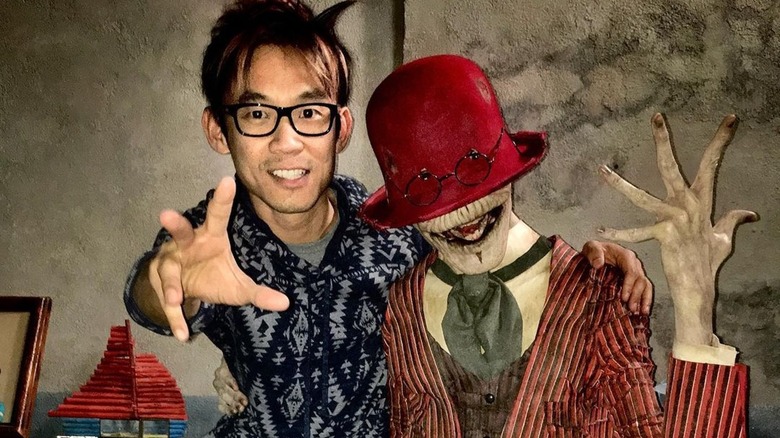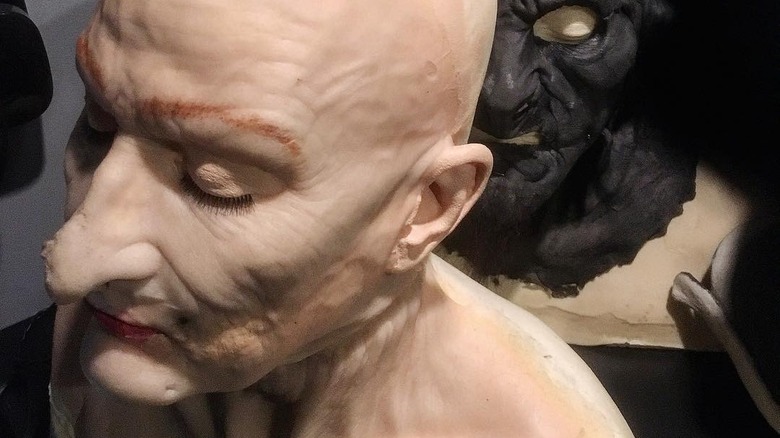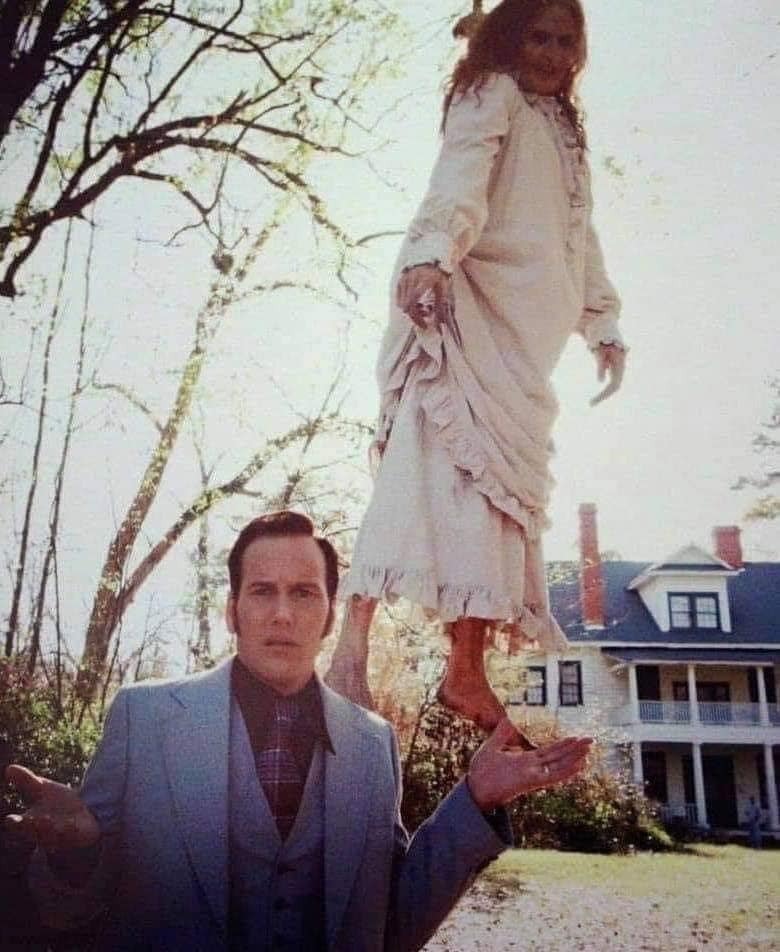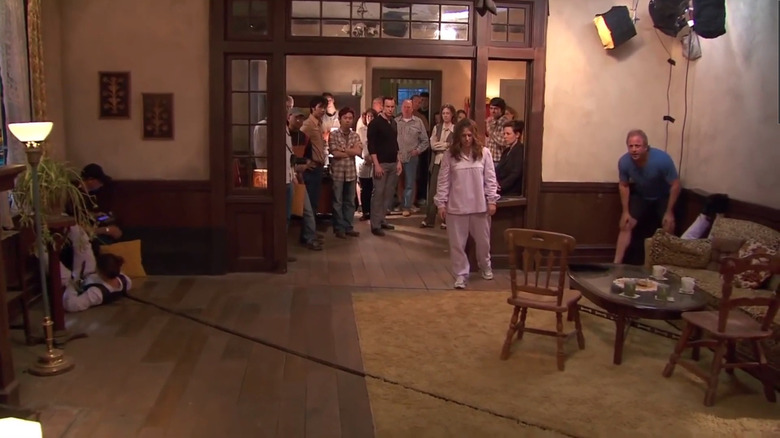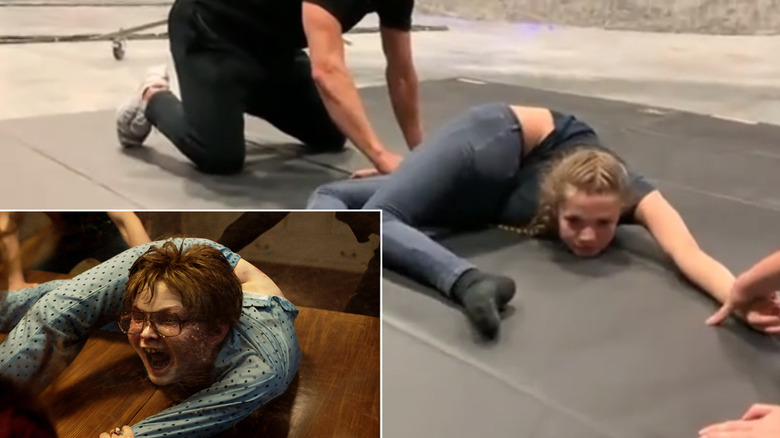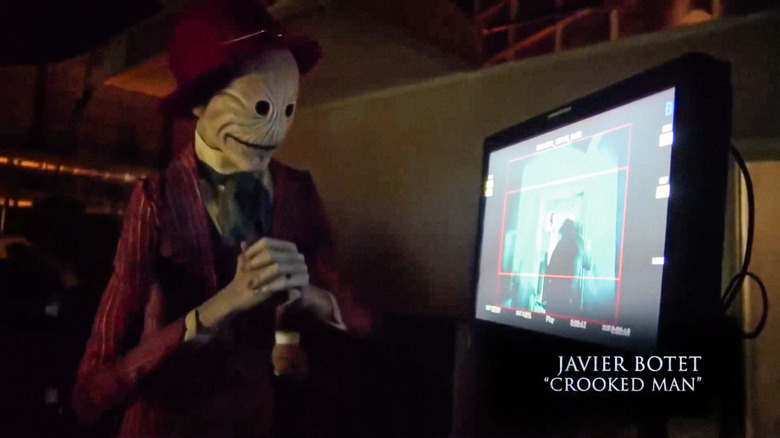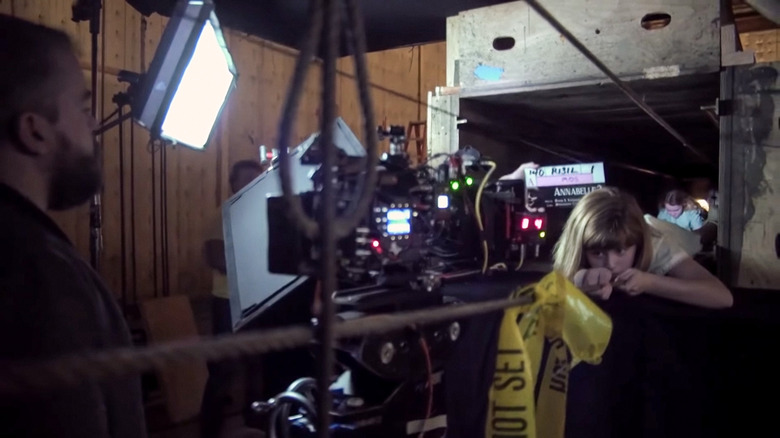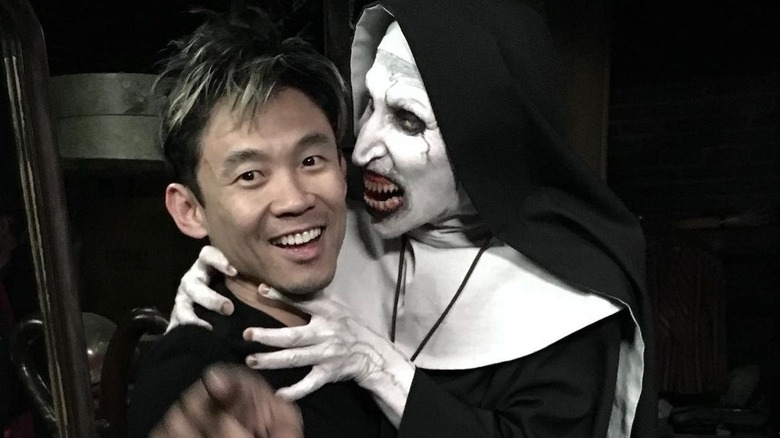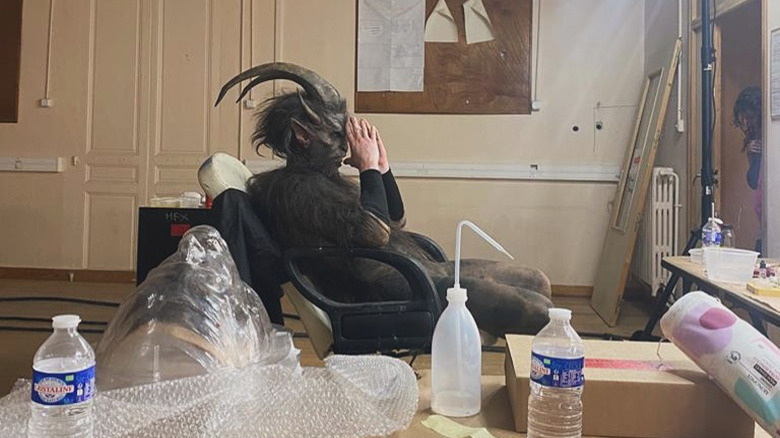What The Conjuring Universe Looks Like Before Special And Visual Effects
One of the most successful cinematic universes in Hollywood doesn't have any superheroes, isn't set in outer space, and wasn't originally designed as a cinematic universe at all. James Wan's 2013 horror movie "The Conjuring" was made on a budget of just $20 million but became a stunning box office success, grossing more than $320 million worldwide. That success has since spawned a whole world of horror that includes not only two "Conjuring" sequels, but also the spin-off "Annabelle" trilogy, two "Nun" movies, and (tenuously) "The Curse of La Llorona."
A big part of what makes the "Conjuring" movies so frightening is their commitment to practical effects. The strangest supernatural feats are achieved using wire work, contortionists, and stunt performers, while monsters like the Nun and the Crooked Man are real actors in make-up.
Digital effects are used sparingly for certain scares where CGI is the best option (like the sheet scene in "The Conjuring"), to remove wires and other unwanted details from a shot, or to enhance the on-set special effects. For the most part, though, most of what you see on the screen in the Conjuring Universe has been achieved using old-school techniques and trickery.
The Conjuring's wicked witch, Bathsheba Sherman
The core of the Conjuring Universe is the "true story" case files of paranormal investigators Ed and Lorraine Warren, played by Patrick Wilson and Vera Farmiga in the films. "The Conjuring" kicked things off with a classic haunted house story about the Perron family: a married couple and their five daughters who, in the 1970s, moved into an old farmhouse and began to experience frightening ghostly phenomena. The most malevolent spirit that allegedly haunted the house was that of Bathsheba Sherman, who had lived on the property in the 1800s and was rumored to have been a Satanist who was involved in the death of a neighbor's child.
In the film, Bathsheba was played by composer Joseph Bishara, who also wrote the score for "The Conjuring" and several other movies in the franchise. Bishara's look was achieved using extensive facial prosthetics and dark contact lenses. One of the most memorable scares in the film involves Lorraine feeling some dark vibes underneath a tree in the farmhouse's yard, and turning to see Bathsheba's feet hanging behind Ed, marking the spot where the witch died. That 50-foot tree was actually built from scratch by the production team, and Bishara did indeed spend a day dangling to create the scare.
Meanwhile, Lili Taylor underwent her own transformation as Carolyn Perron is tormented and eventually possessed by the spirit of Bathsheba. The 1963 horror film "The Haunting" was a major inspiration for James Wan on "The Conjuring," and Taylor had starred in a critically-panned, CGI-heavy remake back in 1999. Taylor had hoped that her imagination might be able to fill in the blanks on the "Haunting" set, but "unfortunately, that just didn't happen," she told Collider. "You start to see everything, but that was abstract to me because it was all green screen. So, to me I was just seeing cones and lights."
"The Conjuring" offered a much more authentic haunted house experience, right down to Taylor's transformation into the possessed Carolyn. The make-up team designed multiple stages of possession, starting with very small details that the audience might not actively notice. "I have these contacts in, these brown contacts and they're so subtle," Taylor revealed. "People are looking at me and they're just cocking their head a little bit, they're not quite sure what's wrong with me, because I'm sort of dead in the eyes."
A double Texas Switch
The restless spirits of the Conjuring Universe can get a little boisterous when it comes to flinging mortals around — whether it's poor Janice (Talitha Bateman) being yanked out of a stair lift and upwards into oblivion in "Annabelle: Creation," or Nancy Perron (Hayley McFarland) being dragged around a room by her hair in "The Conjuring."
Nancy's ordeal is an excellent example of the old-school wire work used in the "Conjuring" films. First, a very fine thread was used to lift a few strands of Harland's hair up towards the ceiling. Then, after Nancy gets yanked into the air and thrown into a glass pane window, Wan and his stunt team set up a classic Texas Switch. In order for the camera to be able to follow Nancy as she's dragged around without needing to cut away, multiple stunt performers were hidden in corners and hooked up to wires on different paths. In the final cut of the scene you can see how Wan pulls off a double Texas Switch in the same shot.
As cool as wire work can be, perhaps even more jaw-dropping is the possession scene at the start of "The Conjuring: The Devil Made Me Do It." While you might assume that this scene required heavy use of both wires and CGI, the most stomach-churning contortions were completely real.
The creepy contortions of David Glatzel
The first unfortunate possession victim in "The Conjuring: The Devil Made Me Do It" is eight-year-old David Glatzel, played by Julian Hilliard. For the opening scene where the Warrens attempt to exorcize a demon from David's body, however, the physical performance mostly came from contortionist Emerald Gordon Wulf. She wore a wig, glasses, and the character's costume, and the visual effects team later completed the disguise by digitally masking her face with Hillard's.
Are contortionists born or made? The answer is "both." They are typically born with the genetic trait of hypermobility, giving them a baseline of extra flexibility in their joints, but it takes a lot of training and practice to able to twist their bodies into extreme shapes like the one seen above. "I love scaring people," Wulf says proudly in a behind-the-scenes featurette for the movie. "It's one of my favorite things about contortion. They don't think it's natural, they don't think a body should be able to do that."
The Crooked Man is more real than you think
Wulf isn't the only performer with an unusual body in the Conjuring Universe. Though the Crooked Man in "The Conjuring 2" is often mistaken for CGI, he's actually played by a real actor in practical prosthetics and make-up. That actor is Javier Botet, whom horror fans will have seen plenty of times — even if they didn't realize it. Botet has played the demonically-possessed Tristana Medeiros in the "[REC]" movies, the titular ghost in the 2013 horror movie "Mama," various spirits in Guillermo del Toro's "Crimson Peak," the title character of 2018's "Slender Man," the demonic KeyFace in "Insidious: The Last Key," and many other spectres and ghouls.
Standing at a towering 6'7" and weighing just 120lbs, Botet was born with a genetic condition called Marfan syndrome. "It makes people skinnier, taller, and very flexible," he explained in an interview with the BBC. "So I was all my life very flexible, all my life doing weird tricks and things to enjoy with my friends [using] very creepy movement."
Botet's Crooked Man is pretty frightening even in photos, but "The Conjuring 2" director James Wan decided to make the movie footage look even more eerie and unnatural. "I filmed him in slowmo and reverse playback — all old-school camera trickery," Wan revealed on Instagram. To create the Crooked Man's strange walk, for example, Wan filmed Botet walking backwards and then reversed the footage and sped it up. It worked a little too well; the results looked so unnatural that Wan finds himself constantly having to correct people who refer to the Crooked Man as a CGI or stop-motion character.
Creating Annabelle
Though James Wan only directed the first two "Conjuring" movies, his love of practical effects and achieving scares in-camera has remained a core part of the franchise. It's not uncommon in horror movies for characters to lose their limbs, heads, or even be cut in half, and since chromakey technology became commonplace this is usually achieved by having the actor wear a green or blue sleeve over the body part that's missing, so it can be removed digitally later on. But for a scene in "Annabelle: Creation" where the top half of Esther Mullins (Miranda Otto) wakes up from death to chase Linda (Lulu Wilson), director David Sandberg instead decided to cast a double amputee as Otto's body double so that no digital trickery would be needed. The role of the undead Mrs. Mullins was played by Katy Sullivan, a Paralympian and bilateral above knee amputee.
Linda escapes the crawling corpse by climbing into a dumb waiter (always a bad idea in a horror movie), only for the contraption to get stuck between two floors. The behind-the-scenes shot above shows how the tense scene of Linda climbing up the dumb waiter with Annabelle (Samara Lee) hot on her heels was filmed using a horizontal set. In a behind-the-scenes clip, Sandberg instructs Wilson to kick her legs up behind her to create the illusion that she's dangling from the rope instead of lying on top of it.
Valak the demon nun
Tied with Annabelle as the most recognizable monster in the Conjuring Universe is Valak, the demonic nun who first appeared in "The Conjuring 2." Valak was originally a winged demon played by Bathsheba actor Joseph Bishara. The nun concept wasn't dreamed up until after principal photography was complete and James Wan was in post-production on the film. "All the nun stuff was shot during additional photography, including coming up with new scare set-pieces like the 'painting on the wall,'" Wan revealed on Instagram. The visual effects team also added shots of the nun into scenes that had previously been shot with the winged demon.
Actress Bonnie Aarons, who once terrified audiences simply by appearing from out behind a dumpster in David Lynch's "Mulholland Drive," was absolutely key to creating the new Valak. Though her appearance was obviously enhanced with make-up and a set of sharp false teeth, Valak's most striking features — the strong nose and piercing hazel eyes — are all Aarons'. Producer Peter Safran recalled that "the moment we saw Bonnie, with the unique geography of her face, everybody said, 'This is exactly who we want, this is who it has to be.'"
From not originally being in the movie at all, Valak's nun form became a centerpiece of the marketing for "The Conjuring 2" and delivered one of the scariest scenes in horror movie history. A spin-off was practically inevitable, and the Conjuring Universe now includes two "Nun" prequels starring Aarons as the nightmarish villain. But for years before her big break, the actress was spurned by Hollywood due to her unconventional looks. "I've literally been told [...] 'No one wants to see somebody that looks like you on TV,'" Aarons revealed to the Hollywood Reporter. "It didn't make me stop. Umpteen years later, hey, James Wan thinks I'm beautiful enough."
AJ the demon goat
When Valak returned in "The Nun II," she had some back-up in the form of a demon goat played by Aaron-John "AJ" North. Transforming into this devilish creature wasn't as simple as just pulling on a mask. "The face is made up of many composite parts so that I can articulate my mouth, I can move my eyebrows," North explains in behind-the-scenes footage. The prosthetics and make-up took four or five hours to apply each day, and an hour to remove, but it was worth it for a look that allowed North to snarl at his prey even through the disguise.
One of the key scare scenes featuring the demonic goat required a lot of dexterity on North's part in order to avoid breaking his neck. Not only did he have to run around on all fours using stilts that extended the length of his arms, he had to do this while chasing a character down a wooden spiralling staircase. "AJ is an incredible creature performer and has incredible endurance," director Michael Chaves enthused. "He was running for days in this goat contraption."
Apparently the devil doesn't get tired.
